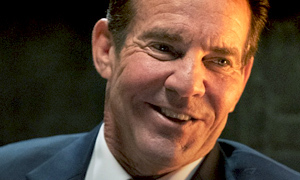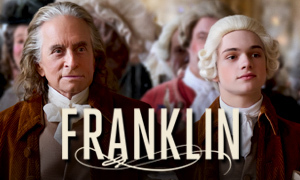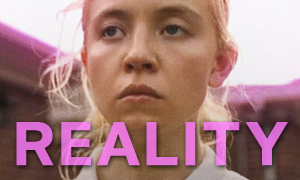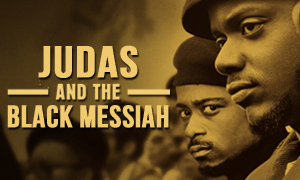Mrs. America: History vs. Hollywood
| REEL FACE: | REAL FACE: |
Cate Blanchett
Born: May 14, 1969 Birthplace: Melbourne, Victoria, Australia | Phyllis Schlafly
Born: August 15, 1924 Birthplace: St. Louis, Missouri, USA Death: September 5, 2016, Ladue, Missouri, USA (cancer) |
John Slattery
Born: August 13, 1962 Birthplace: Boston, Massachusetts, USA | Fred Schlafly
Born: 1909 Birthplace: St. Louis, Missouri, USA Death: 1993, Alton, Missouri, USA |
Rose Byrne
Born: July 24, 1979 Birthplace: Balmain, Sydney, New South Wales, Australia | Gloria Steinem
Born: March 25, 1934 Birthplace: Toledo, Ohio, USA |
Tracey Ullman
Born: December 30, 1959 Birthplace: Slough, Berkshire, England, UK | Betty Friedan
Born: February 4, 1921 Birthplace: Peoria, Illinois, USA Death: February 4, 2006, Washington, D.C. (heart failure) |
Uzo Aduba
Born: February 10, 1981 Birthplace: Boston, Massachusetts, USA | Shirley Chisholm
Born: November 30, 1924 Birthplace: New York City, USA Death: January 1, 2005, Ormond Beach, Florida, USA (stroke) |
Margo Martindale
Born: July 18, 1951 Birthplace: Jacksonville, Texas, USA | Bella Abzug
Born: July 24, 1920 Birthplace: New York City, USA Death: March 31, 1998, New York City, USA (complications from open heart surgery) |
James Marsden
Born: September 18, 1973 Birthplace: Stillwater, Oklahoma, USA | Phil Crane
Born: November 3, 1930 Birthplace: Chicago, Illinois, USA Death: November 8, 2014, Jefferson, Maryland, USA (lung cancer) |
Jeanne Tripplehorn
Born: June 10, 1963 Birthplace: Tulsa, Oklahoma, USA | Eleanor Schlafly
Born: December 21, 1919 Birthplace: St. Louis, Missouri, USA Death: October 31, 2018 |
Elizabeth Banks
Born: February 10, 1974 Birthplace: Pittsfield, Massachusetts, USA | Jill Ruckelshaus
Born: February 19, 1937 Birthplace: Indianapolis, Indiana, USA Photo: UMass Amherst |
Did Phyllis Schlafly model a bikini on stage at a political fundraiser?
The Mrs. America true story reveals that the Hulu series kicks off with a falsehood in the very first scene. The series opens with Schlafly strutting onto a stage in a patriotic swimsuit in 1971, sacrificing her body for her husband's political gain. The men in the crowd whistle, smoke and stare at her lustfully. According to Schlafly biographer Donald Critchlow, author of Phyllis Schlafly and Grassroots Conservatism, he says that the event never happened in real life. Critchlow called the miniseries' depiction of Schlafly "deplorable" and said that she wouldn't even wear a low-cut dress, let alone a bikini. He had looked through the family photo album during his research and never once even saw Phyllis in a bathing suit. Mrs. America wants us to believe that Schlafly was weak and gave in to her husband, letting herself be paraded around as a sex object for his benefit. Critchlow says it's a gross misrepresentation.
Are the closed-door conversations in the miniseries based on actual conversations?
No. Even the show states in a disclaimer that "some scenes and dialogue are invented for creative and storyline purposes." While executing our Mrs. America fact check, we discovered that this is true of most of the conversations that happen behind closed doors in the series.
Did Phyllis Schlafly's position as a conservative activist cause problems in her marriage?
No. The miniseries implies that Schlafly had a troubled marriage due to her position as a conservative spokesperson. In the series, Fred (John Slattery) becomes fed up with his wife's professional life. In one entirely fictional scene, we see him insist that Phyllis (Cate Blanchett) have sex with him despite her utter exhaustion. As Phyllis Schlafly's daughter pointed out during her own comments on the Mrs. America fact vs. fiction, it's one thing to misrepresent her father, it's another thing to imply he committed marital rape against her mother.
Phyllis Schlafly's biographer, Donald Critchlow, told The Federalist, "Phyllis Schlafly had a very, very, very happy marriage. It was one of great respect between her husband who was 12 years older. So the scene where she comes home and he insists upon marital relations is totally, totally absurd." Critchlow says that the real Fred Schlafly had "immense, immense respect for her intellectually and as a person." According to Critchlow, Fred "worshipped Phyllis" and "treated her like a princess." The Los Angeles Times also reported that Fred Schlafly indeed supported his wife, unlike what the series depicts. As a running joke to annoy her feminist opponents, she used to start a speech by thanking Fred for letting her appear at the event, all while chuckling at the absurdity of her needing his permission for anything.
Did an aide in Barry Goldwater's Senate office ask Phyllis to take notes?
No. In the miniseries, Phyllis Schlafly (Cate Blanchett) finds herself as the only woman in a meeting in Senator Barry Goldwater's office. An aide asks her to take notes as if she's a secretary, and she obviously feels demeaned by the request. Schlafly's biographer, Donald Critchlow, says that this would have never happened. "To make her this cowering woman is absurd," noted Critchlow. You need only look to the fact that she took on all of the men in the Republican Party who were for the Equal Rights Amendment, including President Gerald Ford. The notion of Schlafly being at all weak might fit the film's reshaping of Schlafly, but it's a complete deviation from the Mrs. America true story.
Is Phyllis Schlafly's relationship with her sister-in-law, Eleanor Schlafly, depicted accurately?
No. It's clear that the filmmakers didn't care to do their homework when it came to Phyllis Schlafly or her family members, opting instead for heavily fictionalized versions. Schlafly's biographer called the film's depiction of her sister-in-law Eleanor (portrayed by Jeanne Tripplehorn) "downright despicable" and a "travesty." He said that the miniseries' notion that "she wanted to marry a divorced Catholic to see if he was eligible" is "really laughable." The real Eleanor was a conservative Catholic civic leader who co-founded the Cardinal Mindszenty Foundation with her brother Fred and sister-in-law Phyllis. As stated in Eleanor's obituary, the organization functioned "to oppose Communism and to promote traditional religious, family, social, and patriotic values." Eleanor had worked for the Assembly of Captive European Nations, whose aim was to free Soviet-ruled countries from Communist rule.
From all of that we know about the real Eleanor's conservative leanings, the miniseries' assertion that she had become disillusioned with Phyllis's activism is entirely unrealistic. In addition, Phyllis's daughter Anne says that Eleanor was "one of the most forceful women I've ever known." Yet, the Mrs. America Hulu series turns her into a wallflower. Anne says that in real life, if Phyllis and Eleanor were in a room together, Eleanor was the dominant one. "They didn’t have a desire for the truth. They had a desire for their version of rewriting history." -The Daily Signal
Did Phyllis Schlafly oppose same-sex marriage?
Yes. A criticism that the show makes and gets right about Phyllis Schlafly is that she opposed same-sex marriage, and she believed that the Equal Rights Amendment would lead to the legalization of marriage between a man and a man and a woman and a woman. She openly stated that she did not believe that gay couples should have the rights of husbands and wives.
In 1992, Schlafly's eldest son, John, was outed as being gay by Queer Week magazine. The miniseries has him openly acknowledging his sexuality much earlier via various fictional scenes. In real life, John continued to stand by his mother and defended her family values. He worked as the tax attorney for her Eagle Forum. "The family values movement is not antigay," he told the Los Angeles Times.
Was Phyllis Schlafly condescending to her supporters?
No. As her daughter Anne Schlafly Cori stated in an interview, Phyllis was known to be encouraging to her supporters, the exact opposite of what's shown in the Hulu miniseries. While conducting our Mrs. America fact check, we discovered that she had mentored thousands of women, many of whom launched their own organizations at Phyllis's urging. "You can't inspire women or lead a movement if they find you cold and power-hungry and that she was not," says Cori, pointing out that "everybody called her Phyllis." -The Daily Signal
It's also important to note that feminist leaders like Gloria Steinem (Rose Byrne), Betty Friedan (Tracey Ullman), Shirley Chisholm (Uzo Aduba), and Brenda Feigen (Ari Graynor), among others, are showcased heavily in the miniseries, while prominent conservative women who could have been featured are left out, replaced instead by fictional characters who drive the miniseries' narrative. This includes Sarah Paulson's character Alice and Kayli Carter's character Pamela, both of whom didn't exist in real life. Two real-life conservative women who do appear in the series are Rosemary Thomson (Melanie Lynskey) and pro-choice Republican Jill Ruckelshaus (Elizabeth Banks).
Did Phyllis Schlafly try to give outdated canned goods to her black housekeeper?
No. The miniseries implies that Schlafly's own implicit bias and overall lack of self-awareness led her to offer her black housekeeper outdated canned goods from her atomic bunker because she wasn't going to eat them. In investigating the Mrs. America fact vs. fiction, we found no evidence that this scene ever happened in real life. In fact, Schlafly's biographer, Donald Critchlow, told The Federalist that he spoke directly with Schlafly's former housekeeper for his book. "They did have a black housekeeper that was really part of the family ... She was quite forthcoming, and she had great respect for Phyllis Schlafly." He says that the housekeeper continued to work for Phyllis after her husband Fred died and she moved from Alton to St. Louis.
Was Phyllis Schlafly racist?
In the Hulu miniseries, we see Schlafly (Cate Blanchett) defend a racist organizer involved in the Louisiana chapter of the STOP ERA movement. In researching the Mrs. America true story, we learned that this never happened in real life. The racist character, Mary Frances (Melinda Page Hamilton), is fictional. According to Schlafly's daughter Anne, Charlotte Felt was the name of the leader from Louisiana and she was not a racist (The Daily Signal). In real life, Schlafly had actively reached out to the black community, especially black churches, and numerous members had attended STOP ERA conferences.
It's possible that the series is eluding to a small minority of STOP ERA supporters in the South, who had also been involved in activities opposing desegregation. There were also women in some Southern chapters who were involved with the John Birch Society. Schlafly's biographer, Donald Critchlow, says that he found no evidence that Schlafly was ever a member of that society. However, The Daily Beast published an article about a 1959 letter that Schlafly wrote in which she praised the John Birch Society and stated that she and her husband had joined. If this is true, it was likely an effort, albeit a grossly misguided one, to support the society's work to fight Communism, given that this was something she too felt very passionately about (she wrote a book about national defense and spent much of her early career focusing on national security and battling Communism). The Daily Beast article stated that in a 1964 letter, the John Birch Society's founder, Robert Welch, claimed that Schlafly quit the society so that it wouldn't affect the success of her book, A Choice Not an Echo, and in turn hurt the Goldwater cause. Yet, Critchlow said that Schlafly was known to have detested Robert Welch.
An Illinois chapter of the KKK had also come out against the Equal Rights Amendment and openly stated that they were working with Schlafly. However, there is no evidence to support their claim. According to Critchlow, "Schlafly repudiated the KKK." She also stood on the side of Richard Nixon, a proponent of desegregation, in his 1968 campaign against George Wallace. Schlafly's opponents often tried to paint her as antisemitic as well, but she reached out to the Jewish community and was even given an award in the 1950s from the Jewish Christian Fellowship Committee in St. Louis (The Federalist). She also helped to found the strong pro-family movement in the early 1970s and inspired those with different religious affiliations to come together and oppose the ERA. This included Protestants, Catholics, and Jews.
Is Phyllis Schlafly a hypocrite for working outside of the home?
This is certainly what the miniseries implies, but in reality, there are numerous interviews with the real Phyllis Schlafly in which she states that she does not oppose women working outside the home. This was a common misconception about Schlafly since a large part of her activism was to be a voice for homemakers. Calling her a hypocrite was also an easy attack that was used often by her opponents. "I think I represent what women have today, which is true freedom of choice," she said in a Phil Donahue interview in 1974. "They can make marriage and motherhood their fulltime career, or they can go into some other career if they want, or they can do both at the same time. I think the horizons are unlimited for women today."
Does Mrs. America portray Phyllis Schlafly accurately?
No. Aside from actress Cate Blanchett's physical appearance, clipped tones, and mannerisms, which capture Schlafly rather well, Mrs. America on Hulu fails to paint an accurate picture of the activist beyond the superficial. Her story is told through a single political lens, from the point of view of those who stand on the side of the feminists she opposed. Therein lies the problem with Mrs. America. Schlafly is painted as both a misguided villain and a constant silent victim of sexism in her endeavors (as well as at home by a husband who largely casts her aside). Yet, this is how those in Hollywood view Schlafly. It's not at all how Schlafly viewed herself, nor does it line up with the facts or how millions of conservative women viewed Schlafly at the time.
Instead of being lauded for her organizing talent, confidence, and assertiveness, Phyllis Schlafly is portrayed as pushy and self-aggrandizing. The producers use restraint in their villainization of Schlafly. Instead of outright detesting her, we pity her misguidedness as she herself is shown to be a casualty of sexism, even though she's not fully aware. Cate Blanchett's character is both cunning and subservient. However, those who knew the real Phyllis Schlafly described her as extremely warm, charming, gracious, and possessing a great sense of humor. That's not at all the woman on display in the series.
Did the producers contact Phyllis Schlafly's family to help make Cate Blanchett's character more accurate?
No. While performing our Mrs. America fact check, we learned that the producers of the Hulu miniseries purposely excluded Schlafly's family from being involved in the production. Phyllis's daughter, Anne Schlafly Cori, says that she asked and tried to be involved in the production of Mrs. America, but to no avail. "Recently, I read from one of the producers that they very much did not want to talk to any family member, because why confuse yourself [with] the facts when you already have your mind made up of exactly how you're going to portray Phyllis Schlafly." -The Daily Signal
It's also arguably not a coincidence that the miniseries went into production not long after Schlafly's death in 2016 at age 92, when she could no longer speak out against its mischaracterizations.
Does Mrs. America tell the truth about the debate between Fred and Phyllis Schlafly and Marc and Brenda Feigen-Fasteau?
No. One of Mrs. America's biggest fabrications is how the debate plays out in Episode 5 between the two couples, Phyllis Schlafly and her husband Fred and Brenda Feigen-Fasteau and her husband Marc. As it does in the series, the real-life debate took place on a late-night talk show called The Tomorrow Show, which was hosted by Tom Snyder (portrayed by Bobby Cannavale in the series). However, that's where most of the similarities end.
From the opening of the debate, the series depicts Brenda Feigen-Fasteau (Ari Graynor) as having the upper hand and commanding the argument, often leaving Phyllis Schlafly (Cate Blanchett) cowering and at a loss for words. This is almost the exact opposite of how the real-life debate played out, which is confirmed by the footage made available by her organization, the Phyllis Schlafly Eagles. Phyllis never had to be prodded during the debate to provide examples of why she was against the Equal Rights Amendment. She had been debating on the subject of the ERA for over two years by that point and was forthright in providing examples to support her arguments. In fact, she gave a list of examples in the real debate, many of which Brenda Feigen-Fasteau and her husband Marc didn't rebut.
The series goes as far as to show Phyllis's husband Fred looking embarrassed and agitated as his wife stumbles, almost as if he wished he wasn't there. This is a complete fictionalization of the Mrs. America true story and contradicts what the actual footage shows. It was well-known that the real Fred Schlafly supported his wife unconditionally, and they were essentially two peas in a pod when it came to their views on the ERA.
The biggest gotcha moment in the debate in the series comes when Phyllis Schlafly (Cate Blanchett) brings up "a recent Washington D.C. case where three children were given to the father and the mother had to pay child support." Brenda Feigen-Fasteau (Ari Graynor) calls her out and asks her repeatedly, "What was the name of the case?" Phyllis tries to change the subject, but when Brenda insists that she name the case, Phyllis makes up a name and Brenda immediately calls her out for lying, essentially destroying Phyllis in the debate. Not only didn't this moment happen in real life, the exact opposite unfolded during the actual debate.
In real life, it was Phyllis's husband, Fred Schlafly, who called out Brenda Feigen-Fasteau as she made up a fact out of thin air. The real Brenda stated, "Many lending institutions count a woman's income only for half of what it is if she is married and between the ages of 20 and 44 and cannot show that she has been sterilized. That goes for banks, that goes for department stores..." Fred cuts in and asks her, "Are you saying they require women are sterilized?" Brenda responds, "Absolutely." Fred then repeatedly asks her to name one place that requires women to be sterilized. Brenda begins to stumble in almost exactly the same way Mrs. America portrays Phyllis stumbling. Fred keeps pressing her to name one institution. "There was a bank in Queens," Brenda finally replies. "I'm not going to name the name of it," she adds. The host, Tom Snyder, suggests that she should come forward with the name if there's an institution doing that. "Can we just stop," Brenda finally says, realizing she's been caught in a lie.
The altering of the Phyllis Schlafly debate against Brenda Feigen-Fasteau in Episode 5 is one of the most egregious rewritings of history that we've seen in the near two decades we've been fact-checking true story movies and TV shows. Some articles online are mistakenly saying that the debate was taken verbatim from real life. As we've just revealed, this is entirely untrue. However, the authors of these articles do admit that they were unable to find the footage of the actual debate. Instead, they are comparing what's seen in the miniseries to how Brenda Feigen-Fasteau "recalled" the debate in her memoir. It appears that the filmmakers either flat-out lied or did the same.
This was not the first time that Phyllis Schlafly called out a debate opponent for making something up out of thin air. She called out Betty Friedan during a 1976 debate when Friedan said that women were still outright barred to some law schools. "Name one law school that bars women," Phyllis demanded. Friedan stumbled and couldn't name a single law school that still barred women. Phyllis reminded her that it was illegal and a violation of federal law.
Why did Phyllis Schlafly oppose the Equal Rights Amendment?
The miniseries implies that Phyllis Schlafly opposed the Equal Rights Amendment solely to create political favor to help further her own political ambitions. Mrs. America seems to make this argument to avoid tackling the more likely reasons Schlafly opposed the amendment. "My mother got into politics because she wanted to save America," says Schlafly's daughter Anne. "She did not get into politics in order to boost her own ego. ... Her beliefs came from her faith. Her faith formed everything that she believed in politics, and so, when this women's movement came along, she didn't oppose it because she thought it was an opportunity. She opposed it because she thought it would fundamentally change the relationship between men and women and go against her faith in God." -The Daily Signal
"The reason we're against ERA," Schlafly said in a 1977 interview with John Callaway, "is because we are pro-family and pro-women's rights and pro-local self-government instead of the federal government taking over. ... We think that ERA is a massive shift of power from the states to the federal government. ... The whole philosophy of government is saying what government cannot do. That's the way you keep freedom, is putting the shackles on the government to keep them from doing things to you that you don't want them to do to you."
"If you look at [the women's liberation movement's] resolutions, they all call for big brother in Washington to solve their problems for them; take care of their children, find them jobs, give you a shoulder to cry on. All their resolutions are the federal government should do this, and the federal government should provide this type of money, and so forth. And I think it's very interesting that these women, who try to tell the world that they're self-reliant and independent and as capable as men, look to the federal government to solve all their problems."
Schlafly told Phil Donahue in 1974, "I also want to guarantee to the woman who wants to make marriage and motherhood her fulltime career, her legal right to do that, because one of the first things that the Equal Rights Amendment would do is to invalidate the state laws that make it the obligation of the husband to support his wife."
As we examined the Mrs. America fact vs. fiction, we discovered that some of Schlafly's concerns with the Equal Rights Amendment included the potential for women to be subject to the draft, fathers to not have to pay child support, and the potential for millions of existing divorce decrees to be placed in jeopardy. She warned that ex-husbands could go to court and use the ERA as the basis for arguing against supporting their children or having to pay alimony. As expressed in the Mrs. America Hulu series, some women did fear that their ex-husbands could sue for alimony.
Schlafly also believed that feminists would use the amendment as a footing to help achieve other goals, including state nurseries and government-financed abortion, the latter of which she was vehemently against. As a devout Roman Catholic, she was deeply pro-life. A huge problem with the amendment was that it was very vague in its language, and what it could actually do would ultimately end up being worked out in the courts.
Did the Equal Rights Amendment come close to passing?
Yes. Our fact check confirms that with the help of activists like Gloria Steinem (pictured below) and Betty Friedan, the constitutional amendment received an overwhelming endorsement from both major political parties, securing supermajorities in both the House and Senate in March 1972. In order to become law, it needed to be ratified by at least 38 states within a seven-year period. It was ratified by 35 by 1978, falling short by three (five states had rescinded their approvals largely based on STOP ERA petitioning). Congress even extended the deadline by 39 months, but the STOP ERA voices still prevailed.
As various groups today attempt to revive the amendment, we're already seeing evidence of some of its potential pitfalls. We need only look to the transgender women (biological men) who are shattering records held by biological women in sports like weightlifting. And the battle over de-sexed bathrooms is very real today, especially in public schools, despite Schlafly's opponents labeling it fear-mongering at the time (those against de-sexed bathrooms argue, among other things, that they offer a clear opening for sexual assault and a legal defense for sexual predators).
Schlafly realized that equality is not synonymous with sameness. The fact is that men and women are biologically different, and the law must be able to identify circumstances in which the biological differences between men and women are important. According to Schlafly, this included not only in the home, but also in areas such as the military, sports, schools, women's shelters, and correctional institutions, or any place where women are given a safe space based on their biological gender.
Do we currently have equal pay for equal work?
Stating that there is not equal pay for equal work when it comes to men and women is a common misconception spread by those who don't want to look under the surface as to why a man and woman in the same profession might have different salaries. Discrepancies in income are due to many factors, including that many women factor raising children into their careers. Therefore, they often either choose part-time work or eventually leave the profession altogether. They're not as willing to sacrifice huge parts of their lives for a job. Women are also more agreeable than men and are not as forthright when it comes to asking for a raise. Another factor in the overall gender pay gap is the fact that women on average choose careers that pay less than men. Arguably, none of these are necessarily bad things but they are the facts. This is not to say that there are never isolated incidences of gender bias when it comes to wages, but it's not the reason for the differences that we see.
"We have equal pay for equal work since 1963," says Phyllis's daughter Anne Schlafly Cori, "and when these compilations are made of the so-called 'gender wage gap,' it's an average across the whole board. ...and if you work 60 or 80 hours a week, yes, you are going to make more money than if you work 20 or 30 hours a week, and I think it is naive to think that women don’t make different choices on how they want their work-life balance, and for most of the women I know, having a flexible schedule is the single most important factor in a job, and they will trade money for flexibility of schedule. And why? Because they prioritize their family in their life and [don't] we all benefit when women prioritize their family?"
"Look at the incredible number of successful women, not only now but successful women throughout for decades and decades that we've had in the United States, and their success was because they had a positive attitude towards life. They didn't say, 'I'm a victim and the deck is stacked against me.'" -The Daily Signal
Overall, how accurate is Mrs. America?
Mrs. America paints the conservative women who opposed the Equal Rights Amendment as being either opportunists, brainwashed, entirely misguided, or outright fools. As Phyllis Schlafly's biographer Donald Critchlow told The Federalist, "the show obviously contorted Schlafly to fit a narrative, peddling egregious factual inaccuracies that undermine the historical record of her character." She certainly had her flaws, and Critchlow says that he didn't agree with some of her positions. However, Mrs. America is the equivalent of your arch-enemy (at least your political one) trying to tell your story. Do you think you would be portrayed accurately?
As expected, Mrs. America is largely being lauded by liberals and condemned by conservatives. In the vein of numerous other politically-driven films that have come out over the past two decades, Mrs. America is not just revisionist history, it's history reimagined. Filmmakers are all too willing to sacrifice facts in the name of a political narrative, and in the end, they see the viewers the same way they do Schlafly's supporters in the series — as gullible, weak, and willing to believe anything.
Phyllis Schlafly Interviews & Related Videos
Improve your knowledge of the Mrs. America real story and the Equal Rights Amendment by watching the interviews below.







